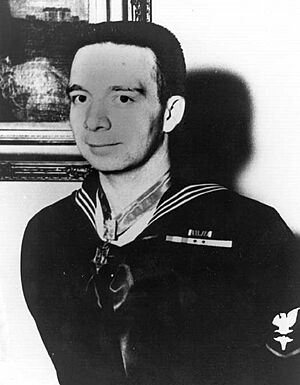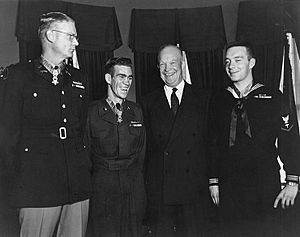William R. Charette facts for kids
Quick facts for kids
William Richard Charette
|
|
|---|---|

Medal of Honor recipient William Charette
|
|
| Born | March 29, 1932 Ludington, Michigan |
| Died | March 18, 2012 (aged 79) Lakeland, Florida |
| Buried |
Florida National Cemetery
|
| Allegiance | United States of America |
| Service/ |
|
| Years of service | 1951–1977 |
| Rank | Master Chief Hospital Corpsman |
| Unit | F Company, 2nd Battalion, 7th Marine Regiment, 1st Marine Division |
| Battles/wars | Korean War
|
| Awards | Medal of Honor Purple Heart Medal |
William Richard Charette (born March 29, 1932 – died March 18, 2012) was a brave United States Navy sailor. He was a Hospital Corpsman, which means he was like a medic for the Navy and Marines. He received the Medal of Honor, the highest award for bravery in the U.S. military. He earned this medal for his amazing courage during the Korean War on March 27, 1953. He served in the Navy for 26 years.
Contents
William Charette was born in Ludington, Michigan, on March 29, 1932. Sadly, both his parents passed away when he was only four years old. His uncle then raised him. He finished high school in Ludington in 1951. After school, he worked on a Lake Michigan ferry boat. This job inspired him to join the Navy.
Charette joined the U.S. Navy on January 11, 1951, during the Korean War (1950–1953). He went through basic training at Naval Station Great Lakes, Illinois. Next, he attended the Hospital Corps School in Maryland. There, he learned how to be a Hospital Corpsman, a medical helper for sailors and Marines. After finishing school, he worked at the Naval Hospital in Charleston, South Carolina. In April 1952, he was promoted to Hospital Corpsman Third Class.
Bravery in Korea
William Charette volunteered to serve in Korea with the Fleet Marine Force (FMF). He would be a medic attached to a Marine Corps unit. In November 1952, he went to Camp Pendleton, California, for special field training. After this training, he became an FMF corpsman. He was then sent to South Korea in February 1953.
Medal of Honor Story
On March 26, 1953, Chinese soldiers attacked Marine outposts in North Korea. One important outpost was called "Vegas." On March 27, Charette's Marine company joined the fight to take back Vegas Hill.
The battle was very dangerous, with many injured Marines. Charette, as a corpsman, had to help them under heavy enemy fire. At one point, an enemy grenade landed near him and a badly wounded Marine. Without thinking, Charette threw himself over the Marine to protect him from the blast. The explosion knocked off his helmet, destroyed his medical bag, and made him unconscious.
When he woke up, his face was bleeding from shrapnel, and he couldn't see clearly. But he pushed through his pain to keep helping. He used pieces of his uniform to bandage wounds. In another moment, he took off his own protective vest and put it on a wounded Marine whose vest was destroyed. He even stood up in a trench, exposing himself to enemy bullets, to carry a seriously wounded comrade to safety.
Charette was badly hurt during this battle. His incredible bravery earned him the Medal of Honor. He was the only living Navy corpsman to receive this medal for actions during the Korean War.

President Dwight D. Eisenhower presented Charette with the Medal of Honor on January 12, 1954, at the White House.
Continuing His Service
After Korea, Charette continued to serve in the Navy. He trained new hospital corpsmen in Illinois. In 1958, he had a special honor aboard the ship USS Canberra. He helped choose the remains of an unknown soldier from World War II to be placed in the Tomb of the Unknowns at Arlington National Cemetery.
Later, he joined the Submarine Service. He was one of the first hospital corpsmen to serve on a nuclear submarine. He worked as an Independent Duty Corpsman (IDC), meaning he was the main medical person on board. He served on submarines like the USS Triton and the USS Sam Houston.
Retirement
William Charette retired from the Navy on April 1, 1977. He had served for 26 years and reached the high rank of Master Chief Hospital Corpsman (HMCM).
Later Years and Legacy
After retiring, Charette was part of several groups, including the Congressional Medal of Honor Society. He passed away at his home in Lake Wales, Florida, on March 18, 2012. He was married for 57 years and had four children. He was buried at the Florida National Cemetery.
William Charette's bravery is remembered in many ways:
- The Charette Health Care Center in Virginia was named in his honor in 1999.
- An AMVETS Post (a veterans' organization) in Ludington, Michigan, was named after him in 1982.
- A large mural in downtown Ludington shows his heroic actions during the Korean War.
- A sign near Spectrum Health Ludington Hospital also honors him.
- A Sea Cadet unit, which trains young people about the Navy, is named the William R. Charette Battalion.
- A new Navy destroyer, the DDG-130, will be named in his honor.
Military Awards
Charette received many military awards for his service and bravery:
 |
||
|
|
||
| Submarine Warfare Insignia | ||
| Medal of Honor | ||
| Purple Heart | Combat Action Ribbon | Navy Unit Commendation |
| Navy Good Conduct Medal w/ one 3⁄16" silver star |
National Defense Service Medal w/ one 3⁄16" bronze star |
Korean Service Medal w/ FMF Combat Operation Insignia and two 3⁄16" battle stars |
| Republic of Korea Presidential Unit Citation |
United Nations Service Medal | Republic of Korea War Service Medal |
See also


